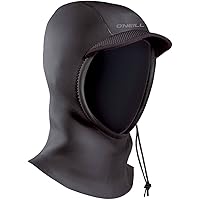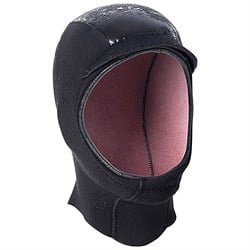If you’re interesting in doing some surfing or stand up paddle boarding in the colder, winter months, then you’ll want to make sure that you invest in a good wetsuit hood.
Sometimes these hoods come as part of a wetsuit, but most of the time you need to purchase one separately.
Below we’ll help you make a smart buying decision on the best wetsuit hood for your cold water adventures.
Benefits of Wetsuit Hoods
Perhaps the first question anyone considering buying a wetsuit hood should ask is “Why does one need a hood anyway?”
Although a hood is generally essential in colder water (48 degrees Fahrenheit or below), it may be optional in warmer water; nevertheless, it’s probably a good idea to wear a hood whenever you dive.
For one thing, your body will stay better insulated if all body parts (especially the extremities, including the head) are properly covered.
Doing so isn’t just a matter of comfort but of reducing chances for hypothermia, providing better protection for your head and reducing chances for unforeseen mishaps.
Depending upon for how long you will you’ll be diving, helping to keep as much heat in your body also means that you will have more energy reserves.
When you dive, you always count minutes because you never know when you’ll need them, especially during accidents, miscalculations and unforeseen mishaps.
Best Wetsuit Hoods For The Money
| PHOTO | HOOD | NOTES | ||
|---|---|---|---|---|
|
Editor’s Pick
 |
Editor’s Pick
|
Vissla 3mm 7 Seas Wetsuit Hood
|
|
Best Price at evo |
|
Also Recommended
 |
Also Recommended
|
O’Neill Psycho 3mm Hood
|
|
Buy at Amazon |
|
Also Recommended
 |
Also Recommended
|
Rip Curl 2mm Flashbomb Wetsuit Hood
|
|
Best Price at evo |
|
Also Recommended
 |
Also Recommended
|
O’Neill Psycho 1.5mm Wetsuit Hood
|
|
Best Price at evo |
What To Look For In A Wetsuit Hood
First of all, most wetsuit hoods are fabricated using neoprene, a material which is very spongy—as such, it contains thousands of tiny air pockets or bubbles which are capable of trapping heat emanating from the diver.
This trapped heat acts as a heating mechanism for the water trapped between the neoprene and the diver’s head.
Not only that, but the trapped heat can’t travel outwardly to the cold water outside the hood and the suit.
If your intention is to dive into relatively cold water, then a high-quality neoprene hood may be one of the most essential pieces of equipment you may need.
And the deeper you will be diving the truer this will be since temperatures take a dive in such waters.
In general, the thicker the neoprene, the warmer you’ll be and the more you’ll be protected from the cold water.
Realize that, for example, a 7mm hood will be much warmer than a 3mm hood.
One thing you can expect in cold water diving hoods are good-size bibs, which are tuckable into wetsuits at the neck openings.
The bib can reduce transferring of water and can keep the diver much warmer.
By the same token, the hoods can cover the forehead (some or all of it) and the chin/jaw areas, including big portions of the diving person’s cheeks.
The point is that very little of the face should be exposed to the cold water, once a mask is added to the ensemble.
In general, cold water hoods are thinner than warm water diving hoods but the cold-water hoods boast of having those larger bibs mentioned.
This can be explained by the fact that the warm water hood varieties are made using thin neoprene (i.e., about 3mm).
Be aware that the nylon options don’t insulate quite as well as the neoprene varieties—then again, they are less burdensome or cumbersome.
The warm-water varieties, as you would expect, also cover less of the diver’s face—in fact, some of them cover small sections of the jaw and very little of the chin.
When shopping for a wetsuit hood, follow the following steps or suggestions:
- Go for models that were made using elastic, stretchy neoprene. These are easier to take off and put on, fit different sized heads more easily and less water generally gets in.
- Go for models that feature a long neck so that you can more easily tuck it into the wetsuit—otherwise, have your neck covered continuously while turning the head.
- By all means, try it on for size before purchasing. Hoods aren’t easy to buy, so don’t rush the process. If you get one that is too big for your head, water will rush in more easily; if the hood was tucked into the suit, it will also find its way into the suit more easily. If the hood is too small, it may put too much pressure on your chin, thus making it difficult for you to breathe.
- Look for a good adjustment-making elastic cord as an integral part of the hood. In general, hoods must provide some kind of adjusting mechanism that can allow for more tightness or the loosening thereof.
- Make sure that you can breathe properly with the hood that you select. If what you are wearing puts too much pressure on your lower jaw, then it will be difficult for you to breathe through your mouth. Make sure that you can adjust or play around with the hood easily and quickly, should you encounter breathing difficulty while submerged. Try breathing through both the mouth and the nose while selecting a hood so you can get a realistic feel for the product.

Getting The Right Fit
Make sure that you don’t have trouble breathing when wearing a wetsuit hood. That’s an issue to properly address before you dive.
You may at times have to breathe through the mouth and you want to select a hood that will comfortably allow you to do that without too much effort or adjustments.
Breathing through the nose will usually not be an issue but, still, you need to find a hood that accommodates both types of breathing, just to be safe.
In general, a good wetsuit hood should provide a snug, comfortable fit.
Hoods that are too loose will allow too much transferring of water and, therefore, heat that should have stayed trapped.
By the same token, hoods that irritate or place discomfort on the neck or throat, may be too small or the wrong fit/model for you.
The hood is too big if water can too easily move in and out.
To make it easier to keep track of your hood (which you are called to sometimes take off) consider getting a model that comes with a zipper on the back of the hood.
This is both a convenient and a practical option that may prevent a mishap; it is also useful for divers with long hair.
Other Considerations
It should be noted that the job of a wetsuit isn’t necessarily to keep water completely out of your suit.
In fact, there is supposed to be a thin layer of water between the suit and your body.
This water is supposed to be kept heated by the natural warmth of your body.
It turns out that water is a better heat/energy transferring device/tool than air—consequently, water trapped inside a wetsuit can be used in your favor and a good hood is part of that water trapping/warming paradigm.
Knowing what type of suit and hood is best suited for the waterway into which you will be diving is essential; you also need to know the temperature of the water–taking into account how deeply you will be diving.
The hood you select needs to be compatible with those things you pre-researched and made plans for.
You also need to take into account the fact that your body has to maintain a healthy body temperature.
In general, the human body may not go too much below or above your natural temperature.
When considering diving equipment and accessories, take the ever-present danger of hypothermia under consideration at all times.
Should You Tuck?
Whether you tuck a long-necked hood or not is a matter of opinion and preference.
Tucking in, it is said, can keep divers warmer but the water that slides past your face will also continue going into your wetsuit.
The fact is that the seals in place are much looser around the face than they are in other parts of the suit.
This may or may not be a problem for some people.
You should experiment with one option, then the other to see what works best for you.
Final Word
Finding the wetsuit hood that is best suited for you depending on several factors, not the least of which is making sure that it is compatible with the wetsuit you own or intend to buy.
Secondly, it needs to fit you well, be suitable for the type of diving you will be doing.
And, finally, meet all the criteria, considerations and requirements briefly touched upon in this guidebook.
| PHOTO | HOOD | NOTES | ||
|---|---|---|---|---|
|
Editor’s Pick

|
Editor’s Pick
|
Vissla 3mm 7 Seas Wetsuit Hood
|
|
Best Price at evo |
|
Also Recommended

|
Also Recommended
|
O’Neill Psycho 3mm Hood
|
|
Buy at Amazon |
|
Also Recommended

|
Also Recommended
|
Rip Curl 2mm Flashbomb Wetsuit Hood
|
|
Best Price at evo |
|
Also Recommended

|
Also Recommended
|
O’Neill Psycho 1.5mm Wetsuit Hood
|
|
Best Price at evo |
